Advertisement
Advertisement
AUD to USD Forecast: Aussie Dollar Reacts to Fed Fear Amid RBA’s Rate Stance
By:
RBA's recent decisions impact the Australian Dollar, but all eyes are on Fed Chair Powell's next move for AUD/USD's fate.
Highlights
- The AUD/USD took a significant dive on Thursday, dropping by 0.98%, influenced heavily by the looming ‘Fed Fear.’.
- Despite 12 rate hikes, the RBA’s stance in August reflects a wary approach, keeping the cash rate at 4.10%.
- Markets’ eyes on Fed Chair Powell; US data takes a backseat.
Thursday Overview
On Thursday, the AUD/USD tumbled by 0.98% to end the day at $0.64172. The Aussie dollar rose to an early high of $0.64881 before sliding to a session low of $0.64125 on Fed Fear.
Market Risk Sentiment to Dictate Pre-Fed Chair Powell
There are no economic indicators from Australia or China for investors to react to this morning. The lack of economic indicators will leave investors to assess central bank positions to tackle inflation, China’s economy, and a shifting macroeconomic environment.
The latest round of Australian economic indicators has closed the door on further RBA rate hikes. In Q2, the annual inflation rate softened from 7.0% to 6.0%. Australian employment numbers also fueled bets on the RBA ending its monetary policy tightening cycle. The Australian unemployment rate increased from 3.5% to 3.7% in July.
An upward trend in unemployment curbs consumer spending, leading to an easing in demand-driven inflationary pressures. The RBA surprised the markets in August, leaving the cash rate at 4.10%. After hiking rates on 12 occasions, the economic indicators suggest that the aggressive monetary policy measures are beginning to take effect.
A deteriorating macroeconomic environment with consumers tightening the purse strings will impact service sector activity and the Australian economy. The services sector contributes more than 60% to GDP. Coupled with China’s economic woes, the RBA’s bid to avoid sending the Australian economy into a recession could be challenging.
In contrast, US economic indicators leave the Fed poised to deliver one final rate hike before hitting the brakes. A hotter-than-expected US economy tilts monetary policy divergence in favor of the dollar.
Fed Chair Powell in the Driving Seat at Jackson Hole
Higher for longer is the theme regarding the Fed interest rate trajectory. While US private sector PMI numbers eased bets on one final rate hike, the tight labor market and wage growth leave investors uncertain.
This afternoon, Fed Chair Powell could remove the uncertainty that has fueled dollar volatility in recent sessions. In July, the US annual inflation rate accelerated from 3.0% to 3.2%, with the US unemployment rate falling from 3.6% to 3.5%.
Considering the Fed’s dual mandate, the simple dynamic of an upward trend in consumer prices and a downward trend in unemployment support a hawkish monetary policy outlook.
However, the Fed will have another round of economic indicators to consider before the September FOMC meeting. Fed Chair Powell could deliver a no-commitment speech on policy or a curve ball by talking about the need to tackle inflation and a tight labor market at the expense of the US economy.
The variables will leave the Aussie dollar in limbo ahead of the Fed Chair Powell speech.
With the markets focused on the Fed, we expect US economic indicators to take a back seat today.
AUD/USD Price Action
Daily Chart
The Daily Chart showed the AUD/USD below the $0.6430 – $0.6450 resistance band. Significantly, the Australian dollar remained below the 50-day and 200-day EMAs, sending bearish near and longer-term price signals.
Looking at the 14-Daily RSI, 35.30 reflects a bearish sentiment. The RSI aligns with the EMAs, signaling a fall to sub-$0.64 to bring the $0.6340 – $0.6320 support band into play. However, a move through the lower level of the $0.6430 – $0.6450 resistance band would give the bulls a look at $0.65.
4-Hourly Chart
Looking at the 4-Hourly Chart, the AUD/USD sits below the $0.6430 – $0.6450 resistance band. The Thursday sell-off left the AUD/USD below the 50-day and 200-day EMAs, affirming the bearish near and longer-term price signals.
Looking at the 14-4-Houly RSI, 43.89 also reflects a bearish sentiment, with selling pressure overweighing buying pressure. The RSI aligns with the EMAs supporting a return to sub-$0.64 to bring the $0.6340 – $0.6320 support band into play. However, a move through the lower level of the $0.6430 – $0.6450 resistance band would give the bulls a run at the 50-day EMA and $0.65.
Price action today will hinge on the heavily anticipated Fed Chair Powell speech from Jackson Hole.
About the Author
Bob Masonauthor
With over 28 years of experience in the financial industry, Bob has worked with various global rating agencies and multinational banks. Currently he is covering currencies, commodities, alternative asset classes and global equities, focusing mostly on European and Asian markets.
Advertisement
